#composer: Ralph Siegel
Text
youtube
Ein bißchen Frieden ist ein Lied, das als deutscher Beitrag zum Eurovision
Song Contest 1982 von Ralph Siegel komponiert, von Bernd Meinunger getextet und von der damals 17-jährigen Sängerin Nicole präsentiert wurde. Es war der erste deutsche und nach Merci, Chérie (Udo Jürgens, 1966) der zweite deutschsprachige Titel, der den Eurovision Song Contest gewann.
A little peace is a song that as a German contribution to Eurovision
Song Contest 1982 composed by Ralph Siegel, texted by Bernd Opinion
and was presented by the then 17-year-old singer Nicole. It was
the first German and after Merci, Chérie (Udo Jürgens, 1966) the second
German-language title that won the Eurovision Song Contest.
#Ein bißchen Frieden - a little peace - Nicole - Melodien zum Träumen - cover an der Wersi Louvre#Youtube
0 notes
Video
youtube
San Marino’s first and so far only qualification!
#esc#eurovision song contest#year: 2014#draw: 25#performer: Valentina Monetta#place: 24#country: san marino#language: english#points: 14#voting: douze points#composer: Ralph Siegel#lyricist: Mauro Balestri#repeat offender
3 notes
·
View notes
Text
A retrospective view on Germany in Eurovision: Part 2 - The Renaissance
Leading up to Mekado’s 3rd place in 1994 there had been some meagre years for Germany in ESC. In 1995 we placed last, which was devastating. And then came 1996, where our entry got disqualified during qualification I think.
So, Germany was at rock bottom. In 1997, no-one cared anymore.
Who could save us?
Well, who else, but “Der Meister” himself? Guildo Horn and his band Die Orthopädischen Strümpfe (have fun looking that up XD) jumped on (and from) Birmingham’s stage, singing a song by Stefan Raab, who - lbr - single handedly brought ESC back into the limelight.
1998: Guildo Horn, “Guildo hat euch lieb” (Guildo loves you)
Everyone talked about him! He was crazy, he looked like that, he was funny but... from Germany?! He placed 7th and made ESC fun again! And seriously? I love that song!
youtube
1999: Sürpriz, “Reise nach Jerusalem - Kudüs’e seyahat”
In 1998 Dana Iternational won for Israel, and composer Ralph Siegel (who also composed Nicole’s winning song) grabbed that chance for this “multi kulti” song. And seriously? I love it! Calculated, perhaps, but it’s actually a really good song, and they sing in German, Turkish, English, Hebrew. Earned 3nd place!
youtube
2000: Stefan Raab, “Wadde hadde dudde da?” (What do you have there?)
He did it. With one of his trademark nonsense songs, Stefan Raab participated himself to do some weird shit. You could not escape that song and we celebrated him like crazy. (⌐■_■)(⌐■_■)(⌐■_■)
youtube
3 notes
·
View notes
Text
Levin Bros: Bananna’s Comedy Shack 2020

Unbeknownst to me, southside stalwart Reggies turned their upstairs space (recently vacated by excellent record store Record Breakers, who moved to Avondale) into a comedy club...which turned out to be the best room for jazz/fusion/prog/etc of the 3 musicrooms in that building. A welcome addition to their arsenal since they’re always bringing such sounds down to Motor Row.
Also unbeknownst to me was the fact that Tony Levin and his brother Pete started a band a few years ago. Instead of blathering on, I’ll just let Pete explain what they sound like:
“We were fascinated by the Cool Jazz of the 50s that we’d listened to as kid. 40/50 years later we could actually sing some of the songs to each other and remember some of the solos we’d heard…pretty amazing. We thought that had some validity, so we decided to do an album and wrote some original music. Over the years we’ve picked up idears...we’d hear something that we want to do – a composer, a rock artist, anybody writing an interesting piece of music – and we’d give it a shot [in that style].”
Levin Brothers
1.16.2020 @ Bananna’s Comedy Shack
Chicago, IL
Out of Darkness
Up From the Skies [The Jimi Hendrix Experience]
Deacon Blues [Steely Dan]
Kakilambe
Peter Gunn Theme [Henry Mancini]
Little Sunflower [Freddie Hubbard]
Bells
The Meaning of the Blues [Bobby Troup]
Jump
Ballad of the Innocent [Jeff Siegel]
When I Was Young
Hidden Drive [David Spinozza]
Gimme Some Scratch
Sleepless [King Crimson]
encore:
Icarus [Ralph Towner]
Pete Levin - keyboards
Tony Levin - electric upright bass
Jeff Siegel - drums
Jeff Ciampa - guitar
stream
download
2 notes
·
View notes
Text
ESC 2019 Reviews - Sweden

Semifinal 2, #8 - John Lundvik, “Too Late for Love”
Ah, yes. The iron maiden. The one that can be weakened but never defeated. The one that’s … overstaying its welcome?
Inside the fandom, opinions are torn over Sweden. On one hand, for the fifth-straight year in a row, we have a solo male singer fronting (Mans, Frans, Robin, Ben, and now, John Lundvik).
youtube
On the other hand… it’s a solid pop song. “Too Late for Love” was co-written by Lundvik alongside well-known Swedish composer Anderz Wrethov and Andreas Johansson. On the third hand (I’m a monster!), Lundvik is the writer of the British entry, which has got to be the most prolific awkwardness outside of Ralph Siegel’s four-thousand total entries. The Eurovision production circle seems like it’s getting smaller and smaller.
While Frans was low-key, and while Ben and Robin leaned in on electro-pop indie vibes, John Lundvik leans back to mainstream pop sounds with added touches of gospel power. There are a ton of highs and lows packed into the three minutes, and although the staging is minimalist, I quite enjoy the dark staging contrasted by bright spotlights.
And those backup singers are *amazing*. They don’t overshadow Lundvik (the questionable authenticity and stereotypes of John and the song aside… do you know what I’m getting at? He’s said in interviews that he didn’t grow up with gospel music, so it’s a bit awkward that he’s singing gospel.) It’s manufactured pop music, but he’s added gospel vocals. Nothing more, nothing less. He has a great voice. And he wrote the darned thing very well.
Before writing the review I was perplexed about how I would justify my rating and rank. Well, I feel like we are so set on ‘bringing a message’ to ESC; admittedly, I just want to turn my mind off and have a little fun. Maybe smile a bit? Dance? John sure does a *ton* of smiling in his performance, considering it’s called “Too Late For Love!” It’s actually alluding to John asking the question to someone who may have previously left him and he being happy to show all the great things he could do for them if they got back together.
What I’m trying to say is that my love for this song is partly the sounds I hear (dance pop is my waifu), the gospel backup singers are throwback, and - yes - I don’t have to think too hard when I hear it. It sounds happy, it looks happy, so it makes me happy. And we need to feel happy about things again and dance the pain away, even when life gets hard. Also, OBLIGATORY KEY CHANGE! Yeah, there’s cheesy moments (especially that last line) but that’s Eurovision for you.
You may not like it. But OKAY if Ben can get 2nd place with the juries with such lame staging and non-existent instrumentation, how would you expect this to place any lower??? It’s a contender for the crown, though it has a ton of competition.
“If I could be there, I would be there.” Someday, my Eurovision pals… someday.
My Rating: 7.5/10
Rank: 5th of 41
#sweden#eurovision#esc#esc 2019#eurovision 2019#john lundvik#too late for love#eurovision song contest#sweden 2019#melodifestivalen
6 notes
·
View notes
Text
LUCY GETS LUCKY
March 1, 1975


Directed by Jack Donohue ~ Written by Robert O'Brien
Synopsis
Lucy Collins comes to Las Vegas to see Dean Martin perform at the newly-opened MGM Grand Hotel. When Lucy's reservation falls through, she hears that Martin is doing a special show for employees and promptly gets herself hired. Naturally, Lucy causes chaos in each department she is transferred to: valet parking, cocktail waitress, Keno girl. But Lucy gets lucky when Dean Martin takes a liking to her and arranges a front row seat at his show.
Cast
Lucille Ball (Lucy Collins) was born on August 6, 1911 in Jamestown, New York. She began her screen career in 1933 and was known in Hollywood as ‘Queen of the B’s’ due to her many appearances in ‘B’ movies. With Richard Denning, she starred in a radio program titled “My Favorite Husband” which eventually led to the creation of “I Love Lucy,” a television situation comedy in which she co-starred with her real-life husband, Latin bandleader Desi Arnaz. The program was phenomenally successful, allowing the couple to purchase what was once RKO Studios, re-naming it Desilu. When the show ended in 1960 (in an hour-long format known as “The Lucy-Desi Comedy Hour”) so did Lucy and Desi’s marriage. In 1962, hoping to keep Desilu financially solvent, Lucy returned to the sitcom format with “The Lucy Show,” which lasted six seasons. She followed that with a similar sitcom “Here’s Lucy” co-starring with her real-life children, Lucie and Desi Jr., as well as Gale Gordon, who had joined the cast of “The Lucy Show” during season two. Before her death in 1989, Lucy made one more attempt at a sitcom with “Life With Lucy,” also with Gordon.
Lucy Collins lives in Los Angeles and took the bus to Las Vegas.
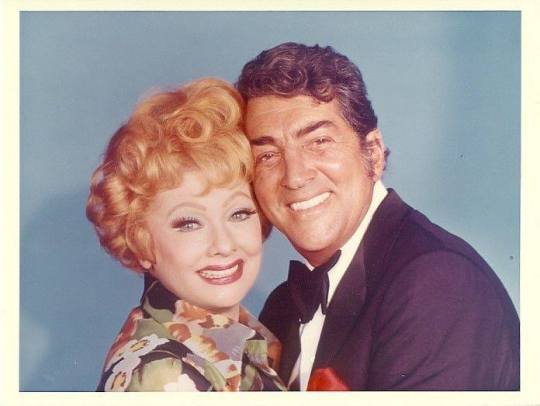
Dean Martin (Himself) also played himself (and his stunt man doppelganger Eddie Feldman) in “Lucy Dates Dean Martin” (TLS S4;E21) in 1966. He was born Dino Paul Crocetti in Steubenville, Ohio, in 1917. He made his screen debut in a short playing a singer in Art Mooney’s band, but his first big screen role was 1949’s My Friend Irma with Jerry Lewis. This began a partnership that would be one of the most successful screen pairings in cinema history. Later, he also worked frequently members of “the Rat Pack”: Frank Sinatra, Joey Bishop, Peter Lawford, and Sammy Davis Jr. His persona was that of a playboy, usually seen with a glass of booze and a cigarette. Martin and Lucille Ball appeared on many TV variety and award shows together. He died on Christmas Day in 1995 at age 78.
Jackie Coogan (Gus L. Mitchell, below center) was a child actor. In “Ricky’s Screen Test” (ILL S4;E6) Lucy Ricardo hopes Little Ricky will be “the next Jackie Coogan.” Coogan was once married to Flower Parry, who was a frequent extra on “I Love Lucy.” He is, of course, best remembered as Uncle Fester on TV’s “The Addams Family” (1964-66). He made two appearances on “The Lucy Show” and on one episode of “Here's Lucy.” He died in 1984 at age 69.
Gus Mitchell is head of personnel at the MGM Grand.
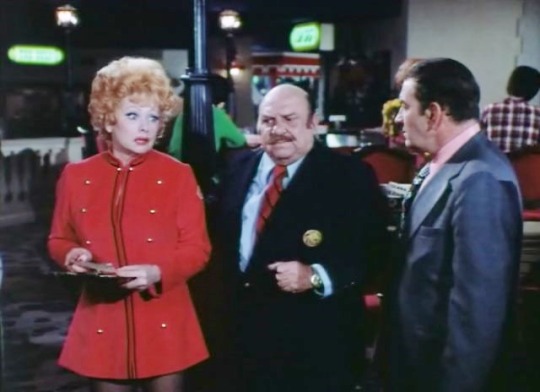
Bruce Gordon (Max Siegel / Vogel, above right) is best known for playing Frank Nitti on the Desilu series “The Untouchables” (1959-63). He played a version of the character when “The Lucy Show” parodied “The Untouchables” in 1966. He was also seen in “Lucy and the Ex-Con” (HL S1;E15) in 1969.
Although the final credits list him as Max Vogel, in the special Gordon clearly says his name is Max Siegel. He is a toy company executive with a business that has been suffering due to shipping problems with their baby dolls.
Paul Picerni (Packy West) was a also cast member of Desilu’s “The Untouchables” from 1959 to 1963. He was seen in four episodes of “Here’s Lucy.”
Lee Delano (Chuck Murdock) previously appeared on the Desilu shows “Star Trek” and “Mission: Impossible.”
Packy and Chuck are Max's gambling buddies.
Ken Lane (Himself) was Dean Martin's musical arranger, pianist, and, alongside Nelson Riddle, also served as composer for this special, although he was uncredited for that work.
Hal England (Dean Martin's Arranger) was an experienced Broadway actor who began screen acting in 1960. He previously appeared in “Lucy and the Astronauts” (HL S4;E5) and “My Fair Buzzi” (HL S5;E13). England died in 2003.
Joey Forman (Eddie) had a nightclub act with Mickey Rooney during the 1950s that led to his appearance on many TV variety shows. He will also appear in “Lucy Calls the President” in 1979.
Eddie is the head of valet parking at the MGM Grand.
Gino Conforti (Antonio) began his TV acting career in 1968 and has been continually working since, although mostly as one-off characters. He had a recurring role as Felipe on “Three’s Company” from 1980 to 1982, a series Lucille Ball admired. He played the burglar in “Lucy Plays Cops and Robbers” (HL S6;E14) in 1974. He will also be seen in and “Three for Two” later in 1975.
Antonio is the Maitre D' at the Celebrity Room. His name is never mentioned in the dialogue.
Vanda Barra (Gladys) made over two dozen appearances on “Here’s Lucy” as well as appearing in Ball’s “Three for Two” (with Jackie Gleason). She was seen in half a dozen episodes of “The Lucy Show.” Barra was Lucille Ball’s cousin-in-law by marriage to Sid Gould.
Gladys is the desk clerk (possibly owner) of the Cactus Flower Motel.
Sid Gould (Taxi Driver) made more than 45 appearances on “The Lucy Show” and nearly as many on “Here’s Lucy.” Gould (born Sydney Greenfader) was Lucille Ball’s cousin by marriage to Gary Morton. He was previously in the Lucille Ball Special “Happy Anniversary and Goodbye.”
Gary Morton (Al) was a comedian who worked the famed ‘Borscht Belt’ in the Catskills Mountains. He met Lucille Ball shortly after her divorce from Desi Arnaz and they married in November 1961. At her request, Morton gave up his nightclub career and became a producer of “The Lucy Show.” Morton also served as a warm-up comic for the show’s studio audience. He is also Producer of this special. Morton passed away in 1999.
Al is a pit boss at the MGM Grand. His name is not spoken in the dialogue.
Bonnie Boland (Sally) played Mabel on “Chico and the Man.” The last of her six episodes aired two weeks after this special was first broadcast.
Sally is a waitress at the MGM Grand Coffee Shop.
Jack Donohue (Ralph) was the director of this special, as well as many episodes of “The Lucy Show” and “Here's Lucy.” He would sometimes make cameo appearances in the episodes he directed.
Joan Swift (Dawn) made six appearances on the “The Lucy Show” as well as two episodes of “Here’s Lucy.” This special is her final screen credit.
Dawn is Ralph's wife. Lucy parks their car when they arrive at the MGM Grand.
Judith Wright (Peggy, Keno Girl)
Jane Aull (Keno Girl) was a background performer making her fifth and final screen appearance.
While making a telephone call, the character is mistaken from the back for Lucy.
Jay Jones (Maintenance Man) makes his screen debut with this special.
Roy Rowan (Voice Over Announcer, uncredited) was Lucille Ball’s announcer for all of her sitcoms. He also made occasional on-camera appearances.
During his introductions, Rowan doesn’t use the show's title, but calls it “The Lucille Ball Special.” This was also the case with “Happy Anniversary and Goodbye,” which had nearly identical voice-over announcements introducing the show.

This was Lucille Ball's second primetime special after the end of “Here's Lucy” in 1974. The first was “Happy Anniversary and Goodbye” four months earlier. After playing a character named Norma in that special, Ball is back to playing a character named Lucy. This time her last name is Collins.
In 1953's “Lucy is Matchmaker” (ILL S3;E27), Lucy tried to fix up Eddie Grant with a girl named Sylvia Collins, although the character remained off-screen.
On “The Lucy Show” Viv’s on-again-off-again boyfriend was named Eddie Collins.
Collins is the surname assigned to Robert Cummings on a 1972 episode of “Here’s Lucy”.
In the film Follow The Fleet (1936), Lucille Ball’s character is named Kitty Collins.
On a 1966 “The Lucy Show” Mr. Mooney and Lucy Carmichael meet the hip hypnotist Pat Collins (her real name)!

This special is available on DVD from MPI video or can be streamed online. It was originally aired on CBS in the USA and ITV in the UK. Like “Happy Anniversary and Goodbye”, this show is sponsored by Timex, which gets opening title credit.

Writer Robert O'Brien had written 54 episodes of “The Lucy Show” and 24 of “Here's Lucy,” many of which were directed by Jack Donohue.
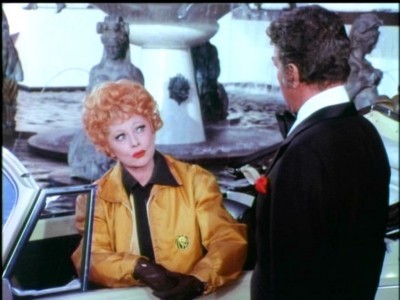
The biggest departure for this special is there is no studio audience or laugh track.
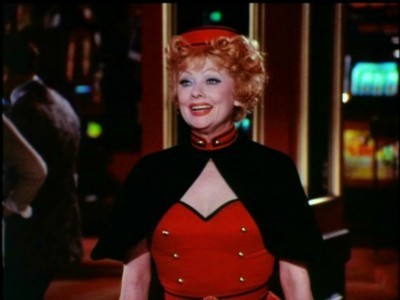
Lucille Ball reunites with many of her “Here's Lucy” production staff, including hairstylist Irma Kusely, prop master Kenneth Westcott, costumer Renita Reachi, production manager William Maginetti, and script supervisor Dorothy Aldworth.
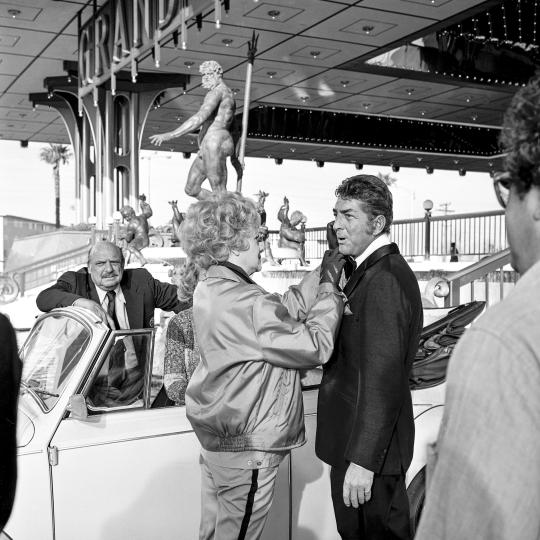
Location shooting was done at the (then) newly opened MGM Grand Hotel in Las Vegas. Scenes set inside the Cactus Flower Motel were shot at Paramount Studios in Hollywood. This is the second time Lucille Ball has shot on location in Las Vegas, the first being at Caesars for “Happy Anniversary and Goodbye.” Although episodes of her television shows were set in the city, actor doubles and second unit footage were used while Ball remained in Hollywood.

Dean Martin's name was seen on the marquee of the Riviera Hotel when Lucy Carter went to Las Vegas in 1970's “Lucy and Wayne Newton” (HL S2;E22, above), three years before the MGM Grand was built. Lucille Ball first used location footage of Las Vegas in “Lucy Hunts Uranium” (LDCH 1958). Lucy Carmichael also visited the town in 1965's “Lucy Goes to Vegas” (TLS S3;E17), however no establishing or location footage was shot, and the episode was filmed entirely on the Desilu soundstage in Hollywood.
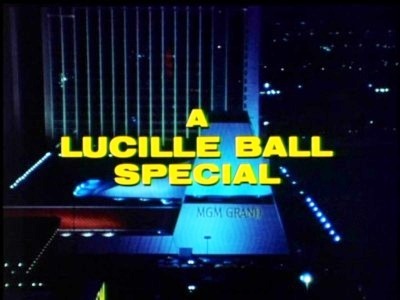
The show opens with a montage of the the Las Vegas strip that includes the marquees of the Caesars Palace, the Flamingo, the Frontier, the Stardust, the Sands, and the Dunes, before ending on the exterior of the MGM Grand. This montage is an aerial view at night, instead of the daytime street view in “Lucy and Wayne Newton” (HL S2;E22).

The MGM Grand opened as one of Las Vegas's first mega resorts on December 5, 1973. Dean Martin was the entertainer on opening night. It was the largest hotel in the world at its opening and would remain so for several years. “The Dean Martin Celebrity Roasts” were filmed at the hotel. The property was sold in 1986 and the name was changed to Bally's. The MGM Grand name was transferred to the former Marina Hotel, now known as MGM Grand Las Vegas.

When Lucy Collins arrives at the MGM Grand with suitcases in hand, she walks through the casino and down their 'Hall of Fame' lined with illuminated posters of movie stars. The soundtrack plays a wistful version of “Hooray for Hollywood.”

Lucy pauses at posters of Spencer Tracy and Katherine Hepburn;
She blows kisses to Cary Grant, whose poster is alongside Grace Kelly.
She gazes lovingly at photos of Frank Sinatra, Fred Astaire and Ginger Rogers. Rogers played herself on a 1971 episode of “Here's Lucy.”
Lucy does a 'ha-cha-cha-cha' in front of a poster of Jimmy Durante, who Lucy Ricardo disguised herself as in “Lucy Meets Harpo Marx” (ILL S4;E28). Durante later did a brief cameo on a 1966 “Lucy Show.”
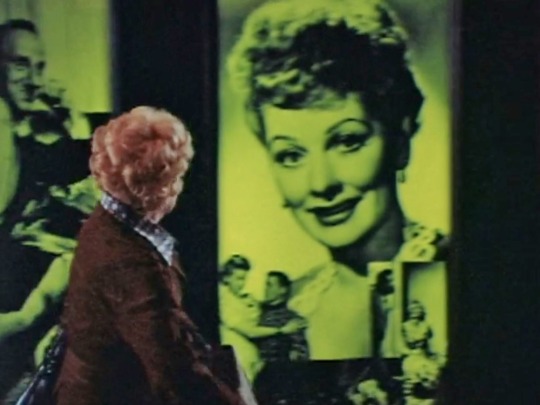
In a meta moment, Lucy Collins then stops and primps her hair in front of a poster of Lucille Ball! Lucy Carter also stood before a poster of Lucille Ball in “Lucy and the Andrews Sisters” (HL S2;E6) and later shared scenes with movie star Ball in “Lucy Carter Meets Lucille Ball” (HL S6;E22). Although her recent film Mame had been released by Warner Brothers, Lucille Ball had done several films with MGM, like The Long, Long Trailer (1954) and Forever Darling (1956).
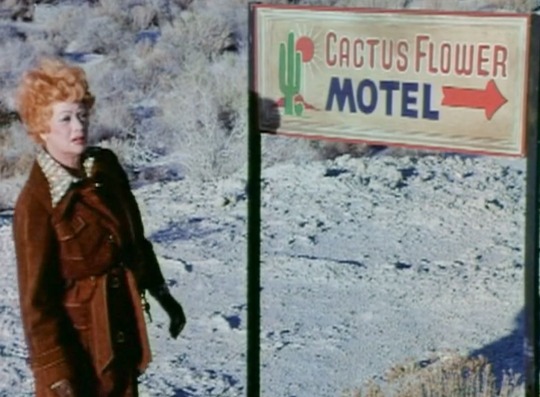
Walking out the employees back entrance and trekking through the desert, it becomes clear that Lucy was only using the MGM Grand lobby as a shortcut to get to her actual lodgings, the Cactus Flower Motel, managed by her friend Gladys (Vanda Barra).
Lucy: (about her dress choices for Dean Martin's opening night) “The other one is older, but its got a Gucci label.”
Gladys: “You have an outfit from Gucci?”
Lucy: “No. Just the label.”
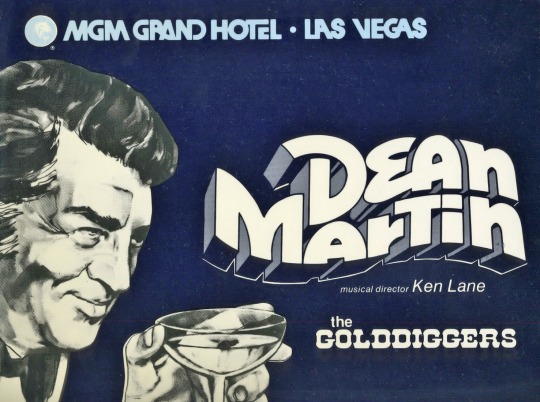
In the MGM Grand coffee shop having a cup of tea in a back booth, Dean Martin sings a few bars of “Volare,” a song written by Franco Migliacci and Domenico Modugno. Martin was one of the first to cover the song in 1958. His orchestra will reprise the song at the end of the special while Lucy and Martin dance.
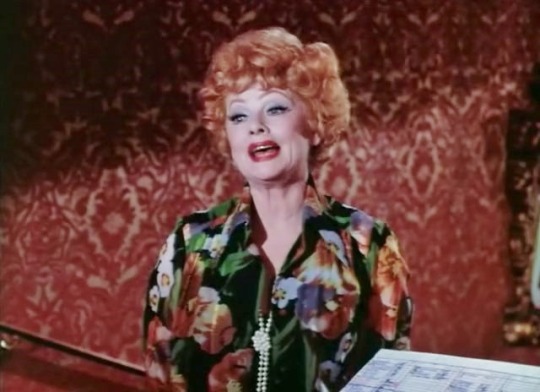
When Lucy phoned for a reservation for Dean Martin's opening night, she lied and said there'd be eight guests. Talking to Antonio the maître d' she must now make excuses for the absence of the seven others.
Mr. and Mrs. Winters are expecting a baby;
Mr. and Mrs. Nichols, Mrs. Winters mother and father, naturally won't be coming either;
Mabel and Henry, Mr. Winters mother and father also aren't coming because of the baby;
Gregory is Mrs. Winters doctor, so he also won't be there;
So it is just Lucy.
Unfortunately, Antonio won't give Lucy a table for one!
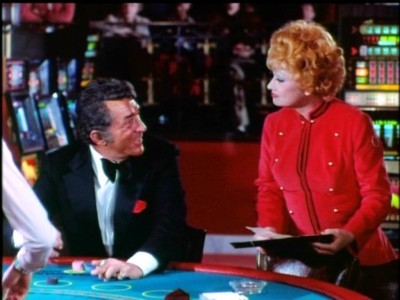
Lucy: “I have been a fan of yours from bobby socks to suphose.”
Dean Martin: “Do you think those suphose would help my problem?”
Lucy: “What's your problem?”
Dean Martin: “I fall down a lot.”
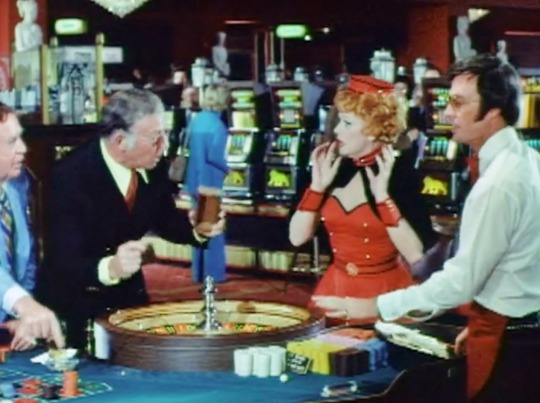
Lucy Collins gets a job as a cocktail waitress and causes chaos at the roulette tables. Lucy Ricardo had some luck (then lost it all) playing roulette in “Lucy Goes to Monte Carlo” (ILL S5;E25). In 1965, Lucy Carmichael had some luck (then lost it all) playing roulette in “Lucy Goes to Vegas” (TLS S3;E17).

The character of Max Siegel (credited as Vogel) is likely named for gangster Bugsy Siegel, who was primarily responsible for the development of the Vegas strip in the 1950s. The fact that Max is being played by Bruce Gordon, famous for playing real-life gangster Frank Nitti on Desilu's “Untouchables,” pretty much assures the comparison. Naturally, Lucy overhears Siegel and his friends talking about “busted up dolls” and thinks they are talking about women, as the term was often used for females in the Damon Runyon musical Guys and Dolls.

Max Siegel's gambling buddy is played by Paul Picerni, another “Untouchables” alumni. His character name is Packy West, which is an obscure reference to Lucy's pal Bob Hope. In July 1919, a 16-year-old Hope entered the Ohio State Boxing Amateurs tournament under the name “Packy East,” a nod to light and welterweight boxer Patrick “Packy” McFarland and Hope's own school, “East” High.

A chase sequence involving Lucy and Max Siegel's gambling buddies ends up backstage at “Hallelujah Hollywood,” a lavish stage show conceived, produced, and directed by Don Arden, It was a 3 million dollar tribute to classic MGM Hollywood musicals which played The Ziegfeld Room (which at the time was the largest stage in the world, with the largest backstage area in the world), at the MGM Grand Hotel in Las Vegas. The show opened in 1974, and ran until 1980. Its flamboyant finale was a tribute to the Ziegfeld Follies, featuring The Grand Stairway and The Great Ziegfeld Walk. The show featured over a 700 costumes (designed by Ray Aghayan and Bob Mackie). Lucille Ball played a lavishly attired Ziegfeld showgirl in the 1946 MGM film Ziegfeld Follies.
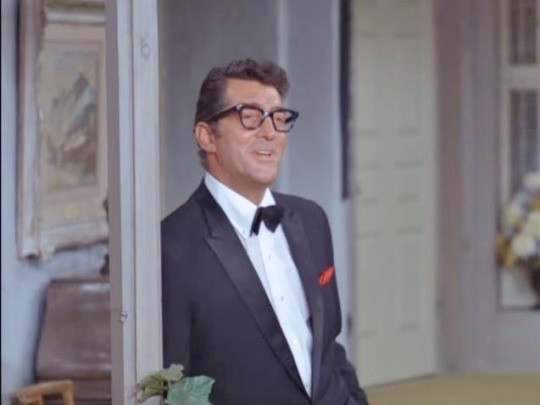
On stage with Lucy in the front row, Dean sings “Everybody Loves Somebody,” a song written in 1947 by Sam Coslow, Irving Taylor. Although it had been recorded by others, it was Dean Martin’s 1964 recording that hit #1 on the Billboard Pop Charts. He also sang it in “Lucy Dates Dean Martin” (TLS S4;E21, above). He then launches into “Tie a Yellow Ribbon 'Round the Old Oak Tree” written by Irwin Levine and L. Russell Brown in early 1973. It was a #1 hit for Tony Orlando and Dawn. The song was referred to by Steve Lawrence (but not sung) in “Lucy, the Peacemaker” (HL S6;E3).
This Date in Lucy History - March 1

“Home Movies” (ILL S3;E20) – March 1, 1954

“Lucy and the Old Mansion” (TLS S3;E22) – March 1, 1965

This is one of the best post-”Lucy” outings of Lucille Ball's career. The reason is simple: She sticks close to what she does best – and she does it without the cloying addition of a laugh track. Had she decided to call the character Lucy Carter instead of Lucy Collins, it might well have been billed as a “Here's Lucy” special. As Lucy Carmichael, she did a similar filmed special titled “Lucy in London” during “The Lucy Show.” Lucy Carmichael dated Dean Martin for one episode, so it would only have worked with Lucy Carter. Perhaps Ball thought people wouldn't remember “Here's Lucy” a year later. But whatever she's named, this special gives us old school, celebrity-hunting, anything-goes, Lucy and it is terrific!

#Lucy Gets Lucky#Lucille Ball#Dean Martin#Las Vegas#MGM Grand#Vanda Barra#Bruce Gordon#Paul Picerni#Jack Donohue#Robert O'Brien#Jackie Coogan#Lee Delano#Ken Lane#Hal England#Joey Forman#Gino Conforti#Sid Gould#Gary Morton#Bonnie Boland#Joan Swift#Judith Wright#Jane Aull#Jay Jones#Roy Rowan#roulette#keno#Volare#Everybody Loves Somebody Sometimes#CBS#MPI Video
9 notes
·
View notes
Video
youtube
The song playing in 12.09 while Crowley and Cas met at the bar...
In Heaven there is no Beer.
From Project Gutenberg:
In Heaven There Is No Beer is a song about the existential pleasures of beer drinking. The title of the song is the reason to drink beer while you are still alive. The song in German is "Im Himmel gibt's kein Bier", in Spanish, "En El Cielo No Hay Cerveza". [3] It was originally composed as a movie score for the film Die Fischerin vom Bodensee, 1956, by Ernst Neubach and Ralph Maria Siegel.[4] The English lyrics are credited to Art Walunas.
In heaven there is no beer.
That's why we drink it here (Right Here!)
When we're gone from here,
all our friends will be drinking all our beer!
#spn 12.09#in heaven there is no beer but here on earth cas is surrounded by meta beer signs >.>#supernatural beer signs#el sol#lonzo's lager sounds like longing lager... but maybe the opposite of longing here...
10 notes
·
View notes
Text
Nature Federal Workers Brace for New Push on Trump Bid to Curb Unions
Nature Federal Workers Brace for New Push on Trump Bid to Curb Unions Nature Federal Workers Brace for New Push on Trump Bid to Curb Unions https://ift.tt/2wDb9wZ
Nature
Image
A Social Security Administration office in the East Village neighborhood of Manhattan. Union officials say labor relations at the agency, already confrontational, have at times been poisonous since President Trump took office.CreditCreditMark Abramson for The New York Times
The Trump administration seemed to suffer a major setback recently when a judge rebuffed its efforts to impose tighter labor rules in federal agencies.
But the judge largely found fault with the means by which it had acted, not with the ends it was pursuing: to make it easier to fire federal employees and limit the power of their unions.
As a result, the administration may yet achieve the same goals. And according to workers and union officials, the effort has already created a climate of anxiety across much of the government.
The administration’s initiative took the form of three executive orders, issued in May, that were officially framed not as mandates but as guidance to take a harder line toward employees and their unions.
Agencies have considerable leeway in their negotiations with unions, which the judge’s ruling generally did not question. The judge simply ruled that management is required to bargain in good faith, and that the president cannot bias the process from the outset or take certain issues off the table. Legal experts say that within those broad parameters, the agencies may be free to tack in the president’s preferred direction, as long as they do so on their own.
Few agencies epitomize this approach better than the Social Security Administration. Union officials say that while management has generally taken a more confrontational posture since the George W. Bush administration, the atmosphere has been poisonous at times under President Trump.
For its part, management complains that labor is too rigid in opposing efforts to serve the growing ranks of benefit recipients better. As the agency’s workload has swelled, its staff has been reduced more than 10 percent, primarily because of congressional spending caps, according to an analysis by Kathleen Romig of the left-leaning Center on Budget and Policy Priorities.
In carrying out the executive orders, which took effect in July, managers scrapped several established union practices. Union officials could no longer use agency equipment like computers for work on behalf of colleagues; they could not use agency office space to meet with workers and store documents; and they could not use the agency’s email system to communicate with colleagues about workplace issues.
Because the executive orders also called for reining in job protections, like the timetable for correcting underperformance and the options for appeals, some managers made clear to workers that their jobs were in greater jeopardy, union officials say.
William Price, president of a union representing Social Security workers in Indiana, said that not long after Mr. Trump signed the orders, a supervisor at an office in Vincennes, Ind., made an ominous comment to a subordinate, saying he supposed that employees could be fired for anything now.
Mr. Price said the comment, which was attested to by an employee who heard it firsthand but who asked to remain anonymous, inspired fear in the office and reflected an increasingly hostile stand by management as the new rules took effect. “I’ve never seen the agency implement any initiative with this kind of fervor,” he said.
On Wednesday, four days after the judge’s ruling, the administration rescinded the provisions that had been ruled illegal. It says it is contemplating its next legal moves.
In the meantime, union leaders worry that the Social Security Administration will seek to enact the same provisions through a short-circuited bargaining process. Under that approach, the agency could declare an impasse, opening the door for an outside panel — a body composed of presidential appointees — simply to impose most of what management had sought.
John Gage, the chief negotiator for workers at the Social Security Administration, said that he had asked his administration counterparts to affirm that they would not base their contract offers on the provisions of the executive orders when negotiations resume in September, and that they had refused. At the moment, he said, “their proposals exactly reflect the executive orders.”
Image
John Gage, the chief negotiator for workers at the Social Security Administration, at a 2011 rally in his previous role as national president of the American Federation of Government Employees.CreditBill Clark/CQ Roll Call, via Getty Images
Mark Hinkle, a Social Security Administration spokesman, said only that the agency and the unions “are currently engaged in negotiating a new collective bargaining agreement.” The agency declined to comment further on any assertions by workers or union leaders.
The rules that applied before the executive orders gave underperforming workers up to 120 days to improve under a structured plan or face termination, depending on the agency. After that, they could appeal their firing to an arbitrator or a government appeals board, a process that typically took several months.
The recent executive orders directed government agencies to try to cap the performance improvement period at 30 days and scale back the avenues for appeals, eliminating the arbitration option. While bringing a case to the appeals board, known as the Merit Systems Protection Board, would still be possible, that can be a more daunting prospect given a backlog built up amid Trump-era vacancies.
Because of the discretion involved in carrying out the orders, different agencies approached the task in vastly different ways. Union officials representing workers at the Defense Department say the agency largely refrained from making or seeking changes laid out in the executive orders.
The Department of Education made changes similar to those in the executive orders even before Mr. Trump took action. A federal labor regulator concluded that the department had acted in bad faith, but it has yet to reverse the changes, according to union officials. (The department did not respond to a request for comment.)
At Social Security, the agency essentially rammed through many of the provisions laid out in the executive orders in July, before undoing them in response to the judge’s ruling last week.
Union officials say that during the intervening weeks, managers in some parts of the agency began to scrutinize employees more aggressively.
“I have noticed a difference in the overall morale of the employees,” said Sonia Saldivar, the president of a union representing Social Security workers in New Mexico. “Employees are scared now. They’re scared they’re going to lose their job.”
Ralph de Juliis, the president of a union that represents Social Security workers in Oklahoma and Arkansas, said that the agency had begun trying to make changes unilaterally to employees’ jobs and working conditions — like specific assignments — that the union previously would have been consulted on.
Even as the pressure on workers increased, unions were at a new disadvantage in defending them. One of the executive orders instructed agencies to sharply reduce so-called official time — that is, the allotment of time for union officials to handle labor issues during work hours. At the Social Security Administration, roughly two dozen officials previously drew a full-time salary while spending most or all of their time on labor issues. The agency left them with no more than a few hours per week to devote to these responsibilities.
Jeremy Maske, the president of a 300-member local in Des Moines, was one of those union officials. After returning to agency work full time in July, he typically woke up about 5 a.m. and spent two hours responding to email about union-related business, then worked on labor matters for several hours in the evening. He went to bed around midnight or 1 a.m. “I feel like I’m in college again,” Mr. Maske said in an interview last month.
Some union officials reported that because grievance or arbitration proceedings typically take place during work hours, they chewed up scarce official time, sometimes making it impossible for union officials to attend. By contrast, the labor relations officials on the management side have no similar limits on the time they can devote to handling workers’ cases.
On Thursday, after the administration complied with the judge’s order, union officials were told that they would be allowed back into their offices on agency property and that their access to email and their official time would be restored.
But even with the reprieve for the union — and even if the judge’s ruling is sustained on appeal — experts said the agency could negotiate on its own to achieve most of Mr. Trump’s goals, in a process in which it ultimately holds the upper hand.
From a judge’s perspective, it may be nearly impossible to distinguish between an agency that takes a hard line with unions and workers at the behest of the president, and an agency that does so on its own initiative. And the latter may not be illegal.
“It’s not clear how they’re required to change their actual behavior,” said Jonathan Siegel, an expert on administrative law at George Washington University. “The legality of the action comes down to the motive with which the action is taken, and it’s difficult to know what the motive is.”
Erica Green contributed reporting.
A version of this article appears in print on
of the New York edition
with the headline:
Labor Rules For Agencies Still at Risk After Ruling
. Order Reprints | Today’s Paper | Subscribe
Read More | https://ift.tt/2NGOzuJ | https://ift.tt/2orp3QW
Nature Federal Workers Brace for New Push on Trump Bid to Curb Unions, in 2018-09-03 00:44:00
0 notes
Text
Nature Federal Workers Brace for New Push on Trump Bid to Curb Unions
Nature Federal Workers Brace for New Push on Trump Bid to Curb Unions Nature Federal Workers Brace for New Push on Trump Bid to Curb Unions http://www.nature-business.com/nature-federal-workers-brace-for-new-push-on-trump-bid-to-curb-unions/
Nature
Image
A Social Security Administration office in the East Village neighborhood of Manhattan. Union officials say labor relations at the agency, already confrontational, have at times been poisonous since President Trump took office.CreditCreditMark Abramson for The New York Times
The Trump administration seemed to suffer a major setback recently when a judge rebuffed its efforts to impose tighter labor rules in federal agencies.
But the judge largely found fault with the means by which it had acted, not with the ends it was pursuing: to make it easier to fire federal employees and limit the power of their unions.
As a result, the administration may yet achieve the same goals. And according to workers and union officials, the effort has already created a climate of anxiety across much of the government.
The administration’s initiative took the form of three executive orders, issued in May, that were officially framed not as mandates but as guidance to take a harder line toward employees and their unions.
Agencies have considerable leeway in their negotiations with unions, which the judge’s ruling generally did not question. The judge simply ruled that management is required to bargain in good faith, and that the president cannot bias the process from the outset or take certain issues off the table. Legal experts say that within those broad parameters, the agencies may be free to tack in the president’s preferred direction, as long as they do so on their own.
Few agencies epitomize this approach better than the Social Security Administration. Union officials say that while management has generally taken a more confrontational posture since the George W. Bush administration, the atmosphere has been poisonous at times under President Trump.
For its part, management complains that labor is too rigid in opposing efforts to serve the growing ranks of benefit recipients better. As the agency’s workload has swelled, its staff has been reduced more than 10 percent, primarily because of congressional spending caps, according to an analysis by Kathleen Romig of the left-leaning Center on Budget and Policy Priorities.
In carrying out the executive orders, which took effect in July, managers scrapped several established union practices. Union officials could no longer use agency equipment like computers for work on behalf of colleagues; they could not use agency office space to meet with workers and store documents; and they could not use the agency’s email system to communicate with colleagues about workplace issues.
Because the executive orders also called for reining in job protections, like the timetable for correcting underperformance and the options for appeals, some managers made clear to workers that their jobs were in greater jeopardy, union officials say.
William Price, president of a union representing Social Security workers in Indiana, said that not long after Mr. Trump signed the orders, a supervisor at an office in Vincennes, Ind., made an ominous comment to a subordinate, saying he supposed that employees could be fired for anything now.
Mr. Price said the comment, which was attested to by an employee who heard it firsthand but who asked to remain anonymous, inspired fear in the office and reflected an increasingly hostile stand by management as the new rules took effect. “I’ve never seen the agency implement any initiative with this kind of fervor,” he said.
On Wednesday, four days after the judge’s ruling, the administration rescinded the provisions that had been ruled illegal. It says it is contemplating its next legal moves.
In the meantime, union leaders worry that the Social Security Administration will seek to enact the same provisions through a short-circuited bargaining process. Under that approach, the agency could declare an impasse, opening the door for an outside panel — a body composed of presidential appointees — simply to impose most of what management had sought.
John Gage, the chief negotiator for workers at the Social Security Administration, said that he had asked his administration counterparts to affirm that they would not base their contract offers on the provisions of the executive orders when negotiations resume in September, and that they had refused. At the moment, he said, “their proposals exactly reflect the executive orders.”
Image
John Gage, the chief negotiator for workers at the Social Security Administration, at a 2011 rally in his previous role as national president of the American Federation of Government Employees.CreditBill Clark/CQ Roll Call, via Getty Images
Mark Hinkle, a Social Security Administration spokesman, said only that the agency and the unions “are currently engaged in negotiating a new collective bargaining agreement.” The agency declined to comment further on any assertions by workers or union leaders.
The rules that applied before the executive orders gave underperforming workers up to 120 days to improve under a structured plan or face termination, depending on the agency. After that, they could appeal their firing to an arbitrator or a government appeals board, a process that typically took several months.
The recent executive orders directed government agencies to try to cap the performance improvement period at 30 days and scale back the avenues for appeals, eliminating the arbitration option. While bringing a case to the appeals board, known as the Merit Systems Protection Board, would still be possible, that can be a more daunting prospect given a backlog built up amid Trump-era vacancies.
Because of the discretion involved in carrying out the orders, different agencies approached the task in vastly different ways. Union officials representing workers at the Defense Department say the agency largely refrained from making or seeking changes laid out in the executive orders.
The Department of Education made changes similar to those in the executive orders even before Mr. Trump took action. A federal labor regulator concluded that the department had acted in bad faith, but it has yet to reverse the changes, according to union officials. (The department did not respond to a request for comment.)
At Social Security, the agency essentially rammed through many of the provisions laid out in the executive orders in July, before undoing them in response to the judge’s ruling last week.
Union officials say that during the intervening weeks, managers in some parts of the agency began to scrutinize employees more aggressively.
“I have noticed a difference in the overall morale of the employees,” said Sonia Saldivar, the president of a union representing Social Security workers in New Mexico. “Employees are scared now. They’re scared they’re going to lose their job.”
Ralph de Juliis, the president of a union that represents Social Security workers in Oklahoma and Arkansas, said that the agency had begun trying to make changes unilaterally to employees’ jobs and working conditions — like specific assignments — that the union previously would have been consulted on.
Even as the pressure on workers increased, unions were at a new disadvantage in defending them. One of the executive orders instructed agencies to sharply reduce so-called official time — that is, the allotment of time for union officials to handle labor issues during work hours. At the Social Security Administration, roughly two dozen officials previously drew a full-time salary while spending most or all of their time on labor issues. The agency left them with no more than a few hours per week to devote to these responsibilities.
Jeremy Maske, the president of a 300-member local in Des Moines, was one of those union officials. After returning to agency work full time in July, he typically woke up about 5 a.m. and spent two hours responding to email about union-related business, then worked on labor matters for several hours in the evening. He went to bed around midnight or 1 a.m. “I feel like I’m in college again,” Mr. Maske said in an interview last month.
Some union officials reported that because grievance or arbitration proceedings typically take place during work hours, they chewed up scarce official time, sometimes making it impossible for union officials to attend. By contrast, the labor relations officials on the management side have no similar limits on the time they can devote to handling workers’ cases.
On Thursday, after the administration complied with the judge’s order, union officials were told that they would be allowed back into their offices on agency property and that their access to email and their official time would be restored.
But even with the reprieve for the union — and even if the judge’s ruling is sustained on appeal — experts said the agency could negotiate on its own to achieve most of Mr. Trump’s goals, in a process in which it ultimately holds the upper hand.
From a judge’s perspective, it may be nearly impossible to distinguish between an agency that takes a hard line with unions and workers at the behest of the president, and an agency that does so on its own initiative. And the latter may not be illegal.
“It’s not clear how they’re required to change their actual behavior,” said Jonathan Siegel, an expert on administrative law at George Washington University. “The legality of the action comes down to the motive with which the action is taken, and it’s difficult to know what the motive is.”
Erica Green contributed reporting.
A version of this article appears in print on
of the New York edition
with the headline:
Labor Rules For Agencies Still at Risk After Ruling
. Order Reprints | Today’s Paper | Subscribe
Read More | https://www.nytimes.com/2018/09/02/business/economy/trump-labor.html | https://www.nytimes.com/by/noam-scheiber
Nature Federal Workers Brace for New Push on Trump Bid to Curb Unions, in 2018-09-03 00:44:00
0 notes
Video
vimeo
Berlin 1920s from Pepa Cometa on Vimeo.
Also on youtu.be/9T6F8um8Wyg
I still have a suitcase in Berlin... (I will come back many times!)
Filmed in Second Life at the beautiful place "The1920s Berlin project", created by Jo Yardley and kept alive by a friendly and active community
maps.secondlife.com/secondlife/1920s%20Berlin%20Project/249/224/1930
Music :
"Ich hab noch einen Koffer in Berlin", composed by Ralph Maria Siegel and sung by Marlene Dietrich.
Many thanks to Jo Yardley and to all the people of Berlin who participated.
More information about the project :
secondlife.com/destination/1828
1920sberlin.com/
1920sberlinproject.wordpress.com/
The Drax Files: World Makers [Episode 2: Jo Yardley] youtube.com/watch?v=EkE_F2nEf4g&list=FLzAausc1lRzrdmQL7vNiqkA
BLOGGED on :
"The creators project" thecreatorsproject.vice.com/blog/somebody-meticulously-recreated-1920s-berlin-in-second-life
"Jo Yardley's Second Life" joyardley.wordpress.com/2016/04/14/1920s-berlin-machinima-shown-on-german-tv/
"secretcitytravel.com" secretcitytravel.com/2016/visit-1920s-berlin-second-life.shtml
"Yopq" yopk.gr/second-life-berlin-1920-project/
"The 1920s Berlin project" 1920sberlinproject.wordpress.com/2016/03/26/pepa-cometa-makes-fantastic-1920s-berlin-project-video/#comment-795
"Echt Virtuell" echtvirtuell.blogspot.com.es/2016/03/video-berlin-1920-von-pepa-cometa.html
"Kill screan" killscreen.com/articles/you-can-visit-a-historically-accurate-1920s-berlin-in-second-life/
"Campaign_Otaku" campaign-otaku.hatenadiary.com/entry/2016/04/26/222626
liveberlin.ru/fun/2017/02/06/berlin-1920s-in-the-second-life/
berlinocacioepepemagazine.com/berlin-1920s-184-secondi-nella-berlino-prima-di-hitler-in-un-corto-danimazione/
"I heart Berlin" iheartberlin.de/2017/03/03/bringing-back-the-golden-twenties-of-berlin-in-second-life/
0 notes
Text
Ralph Siegel knew his song didn't stand a chance
Ralph Siegel knew his song didn’t stand a chance
SAN MARINO – Before shouting at us the next time Valentina Monetta is heavily criticised by oikotimes.com have in mind that the composer of the song, Ralph Siegel knew he didn’t stand a chance to qualify as he admits on a recent interview. He realises (?) that Eurovision Song Contest is more complicated nowadays. For the time being he is heading to some time off not revealing if he will join…
View On WordPress
0 notes
Photo

EV Profile - 🇸🇲 Valentina Monetta is the funky jazz singer who just can't seem to get enough of the Eurovision Song Contest. This year marks her fourth participation in five years but this time she's brought company in the form of American singer Jimmie Wilson. Valentina is well known to followers of the Eurovision Song Contest having participated for San Marino in 2012, 2013 and 2014 when she qualified for the Grand Final. She is currently performing with her band Myfunky Valentine and is excited to be a part of the Eurovision Song Contest once again. "It is one of the biggest chances to show my talent, enjoying music, people and a professional environment", she said. Jimmie Wilson is a singer and songwriter, born in Detroit, Michigan. He came to Europe as the star of Michael Jackson’s musical Sisterella and now lives in Germany. In 2010, he starred as President Obama in the musical Hope. He recently released a brand new album, So Damn Beautiful. "Eurovision is important to me as a singer because you reach a multi-million international audience with ONE performance! Eurovision also stands for diversity and inclusiveness which is so needed in the world today", said Jimmie. Valentina and Jimmie's song for 2017 is Spirit of the Night which was written by Ralph Siegel who also wrote the Eurovision Song Contest winner in 1982, A Little Peace, performed by Nicole, and has participated in the competition a further 24 times. Ralph said; "Music is still my life and the Eurovision Song Contest is the most wonderful possibility to present a song as a composer, that millions of people around the world can hear and hopefully like. As a producer I love to help great artists to be able to show their talent and touch the hearts of the audience. This is my 25th participation in the contest and I want to thank all the artists and musicians that have joined me on this journey". #sanmarino #jimmywilson #valentina #spiritofthenight #celebratediversity #eurovision2017 #Eurovisionsongcontest #EuroRangers #EuroVisionRangers #esc #eurovision (at San Marino)
#eurovision#eurorangers#eurovisionsongcontest#valentina#eurovision2017#eurovisionrangers#esc#sanmarino#spiritofthenight#celebratediversity#jimmywilson
0 notes
Video
youtube
Welcome to semi-final 1!
#esc#eurovision song contest#year: 2009#draw: semi-final 1#performer: Andrea Demirović#place: dnq#country: montenegro#language: english#points: 44#voting: douze points#composer: Ralph Siegel#lyricist: Bernd Meinunger#lyricist: José Juan Santana Rodríguez
1 note
·
View note
Video
youtube
#esc#eurovision song contest#year: 2002#draw: 18#performer: Corinna May#place: 21#country: germany#language: english#points: 17#voting: douze points#composer: Ralph Siegel#lyricist: Bernd Meinunger#big nation
1 note
·
View note
Video
youtube
#esc#eurovision song contest#year: 1981#draw: 3#performer: Lena Valaitis#place: 2#country: germany#language: german#points: 132#voting: douze points#composer: Ralph Siegel#lyricist: Bernd Meinunger
2 notes
·
View notes
Video
youtube
Welcome back to Wind! Fitting their name, they’ve brought some really breezy music.
(incidentally, if you’re having issues getting the video to play, it should be here.)
#esc#eurovision song contest#year: 1987#draw: 16#performer: Wind#place: 2#country: germany#language: german#points: 141#voting: douze points#composer: Ralph Siegel#lyricist: Bernd Meinunger#repeat offender#band
1 note
·
View note